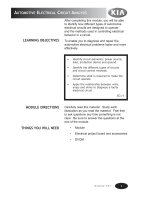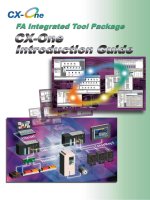CX simulator introduction guide r151 e1 01
Bạn đang xem bản rút gọn của tài liệu. Xem và tải ngay bản đầy đủ của tài liệu tại đây (1.22 MB, 56 trang )
Introduction
- Please be sure to read and understand Precautions and Introductions in CX-Simulator Operation Manual and
CX-Programmer Operation Manual before using the product.
- This guide describes the basic operation procedure of CX-Simulator. Refer to the Help or the Operation Manual of
the PDF file for detailed descriptions.
- Acrobat Reader 5.0 or later is required to read the PDF files.
- You can display the PDF files from the [Start] menu on your desktop after installing the CX-Simulator.
- The screen views used in this guide may be different from the actual view, and be subject to change without notice.
- The product names, service names, function names, and logos described in this guide are trademarks or
registered trademarks of their respective companies.
- The symbols (R) and TM are not marked with trademarks and registered trademarks in this guide respectively
- The product names of the other companies may be abbreviated in this guide.
CONTENTS
Chapter 1 Overview of CX-Simulator
Overview of CX-Simulator
............................................................................... 1-1
Relationship between CX-Simulator and CX-Programmer
Before Installation
............................. 1-1
......................................................................................... 1-1
Major Characteristics of CX-Simulator
............................................................ 1-2
Chapter 2 Creation of Sample Program
2-1 Starting CX-Programmer
......................................................................... 2-1
2-2 New Project Opening and Device Type Settings
.................................... 2-2
2-3 Creating Sample Program
– Car Entry by Opening/Closing a Shutter –
2-4 Saving Program
.......................................... 2-3
....................................................................................... 2-5
Chapter 3 Executing Program by CX-Simulator
3-1 Connection of CX-Simulator Virtual PLC and CX-Programmer ................. 3-1
3-2 Program Transfer to Virtual PLC
.............................................................. 3-2
3-3 Operating Mode Change of Virtual PLC
................................................ 3-4
3-4 Cycle Time Check in Virtual PLC
......................................................... 3-5
3-5 Ladder Monitoring in Virtual PLC
......................................................... 3-6
Chapter 4 Program Debug by CX-Simulator
4-1 Debug with Sample Program
............................................................... 4-1
4-2 Debug by Virtual External Input
4-2-1 Settings of Virtual External Input [IO Condition Tool]
4-2-2 Starting I/O Condition Tool
4-2-3 Setting I/O Conditions
......................... 4-2
............................................................ 4-2
.................................................................. 4-4
4-2-4 Saving and Ending I/O Condition Settings
4-2-5 Debug by Virtual External Input
....................................... 4-7
...................................................... 4-8
4-2-6 Program Debug Operation Using Virtual External Input
................... 4-11
4-3 Debug by IO Break Condition Settings
4-3-1 Setting Contents of IO Break Condition [IO Break Condition Settings] 4-15
4-3-2 Setting IO Break Conditions
......................................................... 4-15
4-3-3 Example of Program Debug Operation by Using IO Break Condition . 4-18
4-4 Other Debug Functions
Running Program in the Unit of Step and Scan, Break Point Setting . 4-22
Chapter 5 Startup from CX-Simulator Menu
5-1 Starting CX-Simulator
.............................................................................. 5-1
5-2 Creating Virtual PLC
............................................................................... 5-2
5-3 Saving/Ending CX-Simulator ..................................................................... 5-7
Chapter 1 Overview of CX-Simulator
Overview of CX-Simulator
CX-Simulator enables you to realize SYSMAC CS/CJ series CPU Units in your computer as a virtual
PLC and operate (simulate) it equally as actual CPU Units.
Combination use of CX-Simulator and
CX-Programmer enables you to verify ladder program operation and cycle time in advance on a PC
without an actual PLC.
Moreover, various debug functions of CX-Simulator make it possible to debug ladders, which used to
be impossible by using an actual PLC only.
Relationship between CX-Simulator and CX-Programmer
CX-Simulator creates a virtual PLC on a virtual network in your PC.
If you use the “Work Online
Simulator“ function of CX-Programmer Ver.3.0 or greater versions, CX-Simulator automatically starts
up a virtual PLC of the current project’s device type to open connection between CX-Programmer and
the virtual PLC.
Before Installation
There are two setup types in CX-Simulator V1.3, but choose “1. For online with CX-Programmer” if
CX-Programmer has already been installed in your computer.
CX-Simulator is automatically installed in the directory where CX-Programmer is installed.
Choose “2. For online with FinsGateway Applications” if you want to use a virtual PLC for the debug of
an application using the FinsGateway network.
Major Characteristics of CX-Simulator
Program execution, monitoring, debug without actual PLC
Monitoring of programs and IO memory present values is enabled.
Moreover, normal debugs such as
force on/off, differential monitoring, data trace and online edit are enabled from CX-Programmer.
Also,
any cyclic task can be started/stopped and interrupt tasks can be started in simulation.
Cycle time check without actual PLC
It is possible to check estimated cycle time (current, minimum, maximum, and mean values, servicing
time *1) when the program is executed in an actual PLC in advance.
Program execution per step or scan, I/O brake condition settings
Debugs that cannot be realized in actual PLCs are provided.
•
Step Run: Executes a program per instruction
•
Scan Run: Executes a program per scan (cycle)
•
I/O Break Condition Settings: Aborts execution when the conditions set in I/O memory are
satisfied.
•
Designation of the start and break points
Debugs in connection with display devices and serial communications devices *1
Regarding the serial communications port of a PC as the communications port of a PLC, it is possible
to debug a program in combination with display devices or serial communications devices (barcode
reader, ID sensor, etc.).
Display of the send messages of serial communications and network
communications *1
It is possible to check the send messages issued by TXD instruction (communications port output),
SEND instruction (network send), and CMND instruction (command send).
It is useful for the debugs
of serial communications and network communications.
*1: You need to start CX-Simulator from the Windows [Start] menu and set a virtual PLC.
Chapter 5 and the CX-Simulator Operation Manual
for the detailed operations.
See
Chapter 2 Creation of Sample Program
This chapter explains basic functions such as programming and comment entry of a simple
ladder by using CX-Programmer.
Here, a sample program “a program of car entry control by opening/closing shutters” is
created as an example.
This program is used to explain how to use the debug functions of
CX-Simulator, which are mentioned after Chapter 3.
Starting CXProgrammer
Windows task bar
[Start]
|
[All Programs
(Programs)]
|
[OMRON]
|
[CX-One]
|
[CX-Programmer]
|
[CX-Programmer]
Opening a
new project
Creating a
sample program
Saving a
program
2-1 Starting CX-Programmer
Start CX-Programmer from the [Start] button in the Windows task bar.
Or double-click the
CX-Programmer icon.
The initial screen of CX-Programmer shows up.
Starting CXProgrammer
Opening a
new project
Creating a
sample program
Saving a
program
2-2 New Project Opening and Device Type Settings
Click the toolbar button [New] in CX-Programmer.
Set the device type to “CS1H” and the CPU type to “CPU63” in this example.
Click the left
mouse button.
Click the left
mouse button.
Click the left mouse button on the
“Settings” button to show the
[Device Type Settings] dialog.
The PLC type is set.
In this example, set
“CS1H”.
The CPU type is set.
In this example, set
“CPU63”.
Here is the end of the
setting.
Now CX-Programmer
is ready for the
connection with
CX-Simulator.
Click the left mouse button on
the spin control button
and select a CPU type.
Click OK to decide the
selected device type.
Starting CXProgrammer
Opening a
new project
Creating a
sample program
Saving a
program
2-3 Creating Sample Program
The following is coding of a simple ladder program by using CX-Programmer.
This is a sample program of controlling car entry in a shed by opening/closing shutters.
When a car approaches, the shutters automatically open; and in two seconds after the
car passes the gate, the shutters close.
Upper limit SW (000001)
Lower limit SW (000002)
Normal rotation motor
(000500)
Reverse rotation motor
(000501)
Arrival detection sensor (000000)
Operation Flow
(1) When a car enters, the arrival detection sensor (000000) is turned on.
(2) The normal rotation motor (000500) of the shutters is turned on.
(3) The shutters reach the upper limit in three seconds, the upper limit SW (000001) is
turned on, and the shutters open.
(4) When the car passes the gate, the arrival detection sensor (000000) is turned off.
(5) In two seconds, the reverse rotation motor (000501) is turned on.
(6) In three seconds, the shutters reach the lower limit, the lower limit SW (000002) is
turned on, and the shutters close.
See CX-Programmer Introduction Guide and the CX-Programmer Operation
Manual for the detailed entry method of a ladder program.
Starting CXProgrammer
Opening a
new project
Creating a
sample program
Saving a
program
Completed Sample Program
The program is modularized in two sections “Shutter elevating processing” and “Entries
count processing” by the section function of CX-Programmer V2 or grater versions.
Shutter elevating
processing
Entries count
processing
Since processing is simplified in the below program, it’s different from the actual
program.
Starting CXProgrammer
Opening a
new project
Creating a
sample program
Saving a
program
2-4 Saving Program
Save the created program.
Here, save the program as “sample”.
Or
select
[File]
|
[Save as] from the
menu.
The program is saved.
This sample program is used in the following operations to explain CX-Simulator.
Keep CX-Programmer open.
Chapter 3
Executing Program by CX-Simulator
This chapter explains how to operate CX-Programmer functions such as program transfer, PLC
mode change, cycle time check, and ladder program monitoring, when CX-Programmer is connected
to a CX-Simulator virtual PLC.
In addition, you can use CX-Programmer when connecting to a virtual PLC by the exactly same
operation as when connecting to an actual PLC.
of CX-Programmer.
For detailed operations, see the operation manual
Connecting to
a virtual PLC
Program transfer
to a virtual PLC
Operation mode
change of a
virtual PLC
Cycle time check
in a virtual PLC
Ladder
monitoring in a
virtula PLC
3-1 Connection of CX-Simulator Virtual PLC and CX-Programmer
Connect CX-Programmer with a CX-Simulator virtual PLC.
The sample program created in Chapter 2 is used for the explanation here.
Starting CX-Programmer
Click the [Open] button from the toolbar of CX-Programmer.
Select the sample program created in Chapter 2.
Select “Sample”.
The sample program
is loaded.
Connecting to
a virtual PLC
Program transfer
to a virtual PLC
Operation mode
change of a
virtual PLC
Cycle time check
in a virtual PLC
Ladder
monitoring in a
virtula PLC
3-2 Program Transfer to Virtual PLC
Click the [Work Online Simulator] button.
Or select [PLC] |
[Work Online
Simulator] from the
menu.
The background
color of Ladder
Window changes to
gray and online
connection is
established.
Now a CX-Simulator virtual PLC and CX-Programmer have been connected.
The Simulator Online function automatically shows the
Transfer dialog after this and enables you to transfer the
ladder program to the virtual PLC; however, you can change it
to the setting of connection only in the option settings of
CX-Programmer.
Connecting to
a virtual PLC
The Transfer dialog is
automatically
displayed.
If CX-Simulator is
installed through
CX-One Ver2.1 or
higher, programs are
automatically
transferred.
Program transfer
to a virtual PLC
Operation mode
change of a
virtual PLC
Cycle time check
in a virtual PLC
Ladder
monitoring in a
virtula PLC
Connecting to
a virtual PLC
Program transfer
to a virtual PLC
Operation mode
change of a
virtual PLC
Cycle time check
in a virtual PLC
Ladder
monitoring in a
virtula PLC
3-3 Operating Mode Change of Virtual PLC
You can change the operating mode of a virtual PLC from the [CX-Simulator Debug
Console] screen or CX-Programmer.
Operation from CX-Simulator Debug Console Tool
To start running a program (Monitor mode)
(Run: Monitor mode)
(Stop: Program mode)
To stop running a program (Program mode)
The number shown in the title bar of Debug Console Tool indicates the count number of
the present cycle in the virtual PLC.
Operation in CX-Programmer
Click the right mouse
button on [NewPLC1]
and select [Operating
Mode].
Or
Select [PLC] |
[Operating Mode] from
the menu.
Connecting to
a virtual PLC
Program transfer
to a virtual PLC
Operation mode
change of a
virtual PLC
Cycle time check
in a virtual PLC
Ladder
monitoring in a
virtula PLC
3-4 Cycle Time Check in Virtual PLC
Change the operating mode of a virtual PLC to the Monitor mode.
Select [PLC] | [Edit] |
[Cycle Time] from the
menu of
CX-Programmer.
Estimated Cycle Time and Simulated Cycle Time
Set Estimated Cycle Time when you want to simulate with accuracy, for instance, when
you want to operate data traced per scan as input.
At this point, the time of one scan
is enlarged, so the present values of instructions such as TIM proceed depending on
your PC performance.
On the other hand, set Simulated Cycle Time, the accuracy is inferior to Estimated Cycle
Time though, when you want to check the exterior operation of instructions such as TIM.
The default cycle time information in CX-Simulator is set to “Simulated Cycle Time”
which is the time for running a program on an active PC. To check the estimated
cycle time when running a program on an actual PLC, change “Cycle Time Mode
Settings” from “Simulated Cycle Time” to “Estimated Cycle Time” in the PLC Clock
Settings of CX-Simulator.
Set “Cycle Time Mode Settings” to “”Simulated Cycle Time” previous to the
following operations.
Connecting to
a virtual PLC
Program transfer
to a virtual PLC
Operation mode
change of a
virtual PLC
Cycle time check
in a virtual PLC
Ladder
monitoring in a
virtula PLC
3-5 Ladder Monitoring in Virtual PLC
Start monitoring of ladders in CX-Programmer.
Besides ladder monitoring, debug operations such as force on/of, differential
monitoring, data trace and online edit are enabled on CX-Programmer as is the case
with connecting to an actual PLC.
Chapter 4
Program Debug by CX-Simulator
The debug operations of a ladder program by using the original functions of CX-Simulator,
which are unavailable by actual PLCs, are explained in this chapter.
Debug with a
sample program
Debug by virtual
external input
Debug by I/O
break settings
Other debug
functions
4-1 Debug with Sample Program
CX-Simulator has various program-debug functions.
Not only ladder program
execution by a virtual PLC instead of an actual PLC, but also the ON operation of a limit
switch after a work moves (I/O condition operation settings), the stop operation of
program execution when a memory value becomes a designated value (I/O break
condition settings), program execution of optional range (Start point/Break point
settings), etc.
This section explains each function by using the sample program “Car entry control
program by opening/closing a shutter“ created in Chapter 2.
The below figure shows the image and operation flow of the sample program in Chapter
2:
Upper limit SW (000001)
Lower limit SW (000002)
Normal rotation motor
(000500)
Reverse rotation motor
(000501)
Arrival detection sensor (000000)
Operation Flow
(1) When a car enters, the arrival detection sensor (000000) is turned on.
(2) The normal rotation motor (000500) of the shutter is turned on.
(3) The shutter reaches the upper limit in three seconds, the upper limit SW
(000001) is turned on, and the shutter opens.
(4) When the car passes the gate, the arrival detection sensor (000000) is turned off.
(5) In two seconds, the reverse rotation motor (000501) is turned on.
(6) In three seconds, the shutter reaches the lower limit, the lower limit SW
(000002) is turned on, and the shutter closes.
In the I/O condition operation settings, you can set the ON operations of the
upper/lower limit switches by shutter elevating operations and the time until the limit
switches are turned on, as virtual external input.
In this example, the virtual external
input that turns on the limit switches of the shutter in three seconds after the motors
are turned on is designated.
Debug with a
sample program
Debug by virtual
external input
Debug by I/O
break settings
Other debug
functions
4-2 Debug by Virtual External Input
CX-Simulator allows you to set external input; for example, the upper limit SW is turned
on in three seconds after the shutter goes up (ON operation of the upper limit switch).
How to set the I/O Condition tool of CX-Simulator is explained below.
4-2-1 Settings of Virtual External Input
In this example, the operations of two external input signals are set.
(1) The upper limit SW (000001) is turned on in three seconds after the normal rotation
motor (000500) is turned on. (At this point, the lower limit SW (000002) is off.)
(2) The lower limit SW (000002) is turned on in three seconds after the reverse rotation
motor (000501) is turned on. (At this point, the upper limit SW (000001) is actually
off.)
Setting in I/O Condition Tool
The following section explains how to set virtual external input by using I/O Condition
Tool:
4-2-2 Starting I/O Condition Tool
Select [Replay] | [IO
Condition] from the
menu in the Debug
Console screen.
I/O Condition Tool
starts up.
Select [I/O Condition] from the Debug Console screen.









